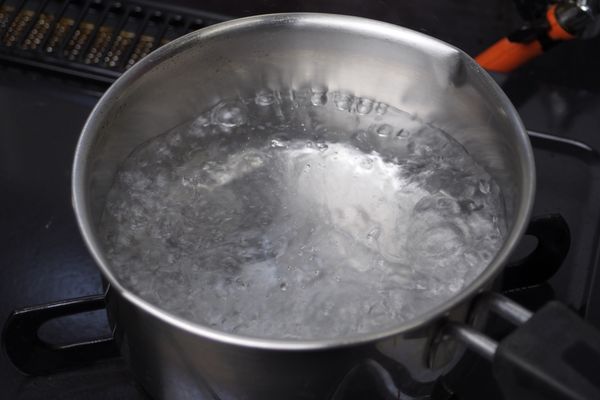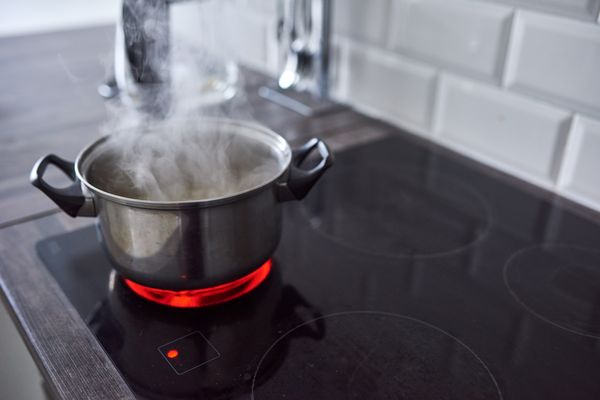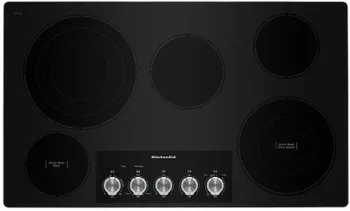
At a Glance:
Best Cooktop Surfaces for Simmering
Are you a whiz in the kitchen, but can’t seem to master the art of simmering? Today is the day you learn everything there is to know about simmering, including the answer to “What is a simmer on the stove?” and “What does a simmer look like?” In this guide, we’re sharing helpful insight into mastering the art of simmering, tips on temperature control, and how to achieve the perfect simmer, as well as look at some powerful cooktops to help bring versatility and flavor to your cooking game.
Discover Cooktop Deals
Hone your cooking skills with a top-rated cooktop from Albert Lee Appliance.
Shop NowWhat is a Simmer?

What does simmer mean in cooking? In essence, a simmer is when you gently cook food over a low to medium-low heat to maintain a temperature just below the point of boiling, which is between 185°F to 205°F.
Importance of Simmering in Various Culinary Applications
Simmering is an effective way to develop deep flavor in your foods. Most commonly, you will find instructions for simmering soups, sauces, stews, and even tough cuts of meat. Simmering improves the overall flavor, texture, and consistency of your dish, and if you are a culinary genius or just starting on your culinary journey, mastering the art of simmering is something worth checking off your skill list. Let’s take a look at some of the roles simmering plays in various types of culinary applications.
| Simmering Applications | How to Use It | ||
|---|---|---|---|
| Reduction | Mastering the art of reduction is vital for creating flavorful dishes and is extremely helpful in creating the ideal thickness in sauces and soups. Reduction is the process by which you allow the food to cook low and slow, or simmer, and reduce the volume of liquid by evaporating any excess moisture. | ||
Simmer vs Boil
Simmering offers different results than other forms of cooking methods, due to the nature of allowing the flavors and ingredients to cook on a low, slow heat for a long period of time. When looking at the differences between simmering and boiling, the recommended heat for simmer is 185°F to 205°F, while the heat recommendation for a boil is around 212°F. Simmering does not produce the rapid bubbles that boiling does, simply due to the fact of the lower temperature, as when you are simmering, you are creating bubbles that are barely breaking the surface of the liquid, while a boil creates vigorous, constant bubbling.
Achieving the Perfect Simmer

Achieving the perfect simmer may be easier than it sounds. By following simple steps, you can be on your way to achieving the perfect simmer, to create flavorful, restaurant-quality dishes that everyone can enjoy. Let’s take a look at some recommendations on how to achieve the perfect simmer.
Essential Cookware for Simmering
Before you begin the process of simmering, you want to make sure you have the proper cookware. Starting with the wrong cookware gets you off to an unwanted bad start, so make sure that you grab the proper size pot or saucepan with a properly fitting lid that will be sufficient for the amount of food you are cooking. Choose a heavy-bottomed pot or saucepan to allow for even heat distribution and consistent simmering. Other cookware essentials are a thermometer to monitor heat and a wooden spoon or silicone spatula for mixing.
Temperature Control and Precision
When you are looking to create the ideal simmer, you want to make sure you keep a careful eye on the temperature at which your food is cooking. If you go too low, the food will not cook properly, which results in less flavor and texture, and if you go too high on the temperature, you will quickly find yourself fighting a vigorous boil. Starting with high heat, bring the desired ingredients to a boil, and then reduce the heat setting immediately to bring to a low simmer. You should see the liquid start to bubble, but not vigorously. Once at a simmer, you want to maintain the proper simmer temperature (185°F to 205°F), which can easily be monitored with a kitchen thermometer. Reduce or increase heat as needed until you get the desired flavor or texture.
Cooking Techniques
Practice proper cooking techniques like stirring and skimming as the recipe calls for it. Some recipes call for constant stirring while other recipes do not, so be sure to follow the recipe for the stirring recommendations. Another thing that can be useful while simmering is skimming. Skimming can help take off excess foam or impurities from dishes like soups or sauces.
Best Cooktop Surfaces for Simmering
Having a reliable cooking tool is half the battle when it comes to conquering any cooking technique. Take a look as some common cooking appliances and how simmering works on each platform.
Smooth Glass Electric Cooktops
Achieving a proper simmer on a smooth glass electric cooktop may be different than cooking on a raised coil electric cooktop. When you are trying to simmer on a smooth glass electric cooktop, follow the guidelines of starting with high heat and then bringing it down to a simmer while monitoring and stirring your foods as recommended. If you are struggling to maintain a simmer on a smooth glass electric cooktop, consider using a ceramic or metal plate as a heat diffuser. To do this, simply place the plate between the burner and the pot, and allow the diffuser to maintain an even heat. Opt for smooth-bottomed pots or pans to achieve the right contact with the cooktop, and make sure to choose compatible materials, such as stainless steel or cast iron.
Recommended Smooth Top Cooktop: KitchenAid® 36" Stainless Steel Electric Cooktop

Shop This KitchenAid Electric Cooktop
Harness the power of this KitchenAid® 36 cooktop, which offers a 6'' Even-Heat Element with Melt Setting, two 6'' 1200-watt Round Elements, a 12''/9''/6'' Triple-Ring Round Element, and best of all, a 10'' Even-Heat Ultra Power Element with smooth, simmering performance. This cooktop offers ultimate flexibility for every cooking need and the power necessary to create flavorful, succulent dishes. With the 10” Even-Heat Ultra Power Element, you can count on an even heat distribution through the entire pan, and a range of simmer settings for all your culinary needs.
Featured KitchenAid KCES556HSS review: “Love my new cooktop! The dual and triple surface elements are perfect for my cooking needs. Easy to clean glass top, heats very quickly, a lot of space. I cook for a large family at times and have more room for my pots and pans than before on the old 36" cooktop. Love it!”
Related: Pro Tips on How to Clean an Electric Stove Top
Induction Cooktops
Induction cooktops offer many advantages for simmer cooking, from even heat distribution, powerful precision, rapid heat response, and energy-efficient properties. Induction cooktops bring the heat directly to the cookware rather than to the cooktop itself, creating a more direct heat than gas or electric cooktops. To achieve the perfect simmer on an induction cooktop, be sure to start with a flat, ferrous bottom pot or pan, such as stainless steel or cast iron. Choose the burner on the cooktop that best matches the size of your cookware, and thenmbring your food to a boil first and then reduce down to a simmer temperature. Once you have the cooktop in the proper setting, induction cooktops do the rest of the work for you by maintaining temperature fairly effectively, so there is usually no need to adjust the temperature throughout the cooking process.
Recommended Induction Cooktop: GE Profile™ 36" Black Induction Cooktop

Shop This GE Profile Induction Cooktop
Maintain perfect simmering temperature with ease and consistency on the GE Profile 36" black induction cooktop. With the Power Boil setting, you can easily get your foods boiling, and then quickly reduce them to a simmer by using the Precision Temperature Control feature. Cooking flavorful meals for the whole family to enjoy has never been easier on this induction cooktop, which offers 19 different heat settings, guided cooking, an easy-to-clean surface, and much more.
Featured GE Profile PHP9036DTBB review: “I always thought gas cooking would yield finer control. The new induction stovetop is faster to heat and quicker to cool because there is no hot burner that must cool before the cookware cools. Helps eliminate overcooking and burning more delicate foods.”
Related: 5 Top-Rated 36 Inch Induction Cooktops
Gas Cooktops
Gas cooktops off a wide range of temperature settings and instant heat control that are perfect for creating a perfect simmer, they also don’t require special cookware like induction cooktops do. With even heat distribution, you can easily heat the whole pan, and negate the risk of unwanted hotspots while using a gas cooktop. To create a simmer on a gas cooktop, simply choose the pan of your choice, and match the cookware to the correct burner. Turn on the gas, bring your food to a boil, and then reduce the heat and allow it to simmer. Once you have the proper temperature, you can use simmer rings or diffusers to help distribute the heat more evenly. Be sure to stir often when simmering on a gas cooktop to avoid sticking, and keep a close eye on the flame to ensure it is staying low, which is ideal for simmering on a gas cooktop.
Recommended Gas Cooktop: Samsung 36" Stainless Steel Gas Cooktop

This Samsung gas cooktop brings both power and design to your kitchen. With the cast-iron grates, you get a modern, industrial-style look, while enjoying powerful cooking features like the 19K BTU Power Burner, which is ideal for a powerful boil or a low simmer, depending on your cooking needs. Wi-Fi connectivity gives you control over your cooktop from anywhere in your home, while the blue illuminated knobs show you when the cooktop is on or off.
Featured Samsung NA36N6555TS review: “I had this installed a couple of weeks ago and absolutely love it! First upgrade since we had the home built 19 years ago. Love the 5 burners over 4 and be sure to read all the material especially the size of pots or pans you can place on the front burners. They show that you can only place a 10" pot or pan on those 2 burners as anything larger will most like damage the control knobs! Glad I read them all.”
Related: Top 6 Gas Ranges | Features and Recommendations
Troubleshooting Common Simmering Issues
Even the best cooks have a hiccup here and there. That’s part of the joy of cooking. Regardless, here are a few tips to consider if you find yourself struggling to achieve the perfect simmer.
- Uneven Simmering: If you notice your food is not simmering evenly, you can gently stir the contents to help distribute the heat throughout the pot. Make sure you are also choosing flat-bottomed cookware and not uneven, warped cookware, which can cause uneven heat distribution.
- Excessive Bubbling: Simply lowering the heat will prevent excess bubbling and maintain the slower bubbling indicative of simmering.
- Preventing Boil-Overs: If you are experiencing constant boil-overs when simmering, be sure that you are using the correct size cookware for the volume of food you are cooking, as well as maintaining proper temperature recommendations to avoid creating a vigorous boil, which can quickly cause boil-overs.
- Adjusting for Different Recipes: Not all simmer recommendations are the same and can vary from recipe to recipe. Be sure to follow the instructions for the type of food you are cooking, and use the correct cookware, temperature, and simmering time to get the best results.
Whether you’re a seasoned vet or a newbie in the kitchen, learning how to achieve the perfect simmer can help you in creating delectable dishes to share with those you love. Simmering offers dynamic flavor and texture to any dish, whether that be sauces, soups, meats, veggies, and more. At Albert Lee, you can find a wide array of ranges and cooktops to help you be the best you can be in the kitchen, experiencing features and cooking options to elevate your culinary experience every time.
Why Trust Albert Lee?
Since 1939, Albert Lee Appliance, a three-generation, family-owned business, continues to grow and serve the greater Seattle area with quality products you can count on and service you can trust. We are proud to have served this community for so long and wouldn’t be here without our loyal customers. There is a reason why we are Washington’s largest independent appliance dealer, and it’s not a secret. Simply put: We have the experience. We have been the original appliance experts for over eight decades (and counting).
Shop Cooking Appliances at Albert Lee
At Albert Lee Appliance, we provide quality name-brand appliances for great prices. Shop cooking appliances online or visit us today at one of our six locations in Puget Sound, WA. In the meantime, browse our website to shop Albert Lee appliance sales and check out Albert Lee appliance reviews online to ensure every purchase is an informed one. More available than ever, our experts at Albert Lee Appliance are always happy to help you determine what does a simmer look like, whether you call us or use our online chat feature. Contact us today!
